Probiotics on Upper Respiratory Tract Infections during Long COVID
VerifiedAdded on 2023/06/12
|12
|3171
|58
Literature Review
AI Summary
This literature review investigates the potential of probiotics in treating upper respiratory tract infections (URTIs) in individuals experiencing long COVID. It begins by introducing the prevalence and impact of URTIs, particularly in the context of the SARS-CoV-2 pandemic, and highlights the potential of probiotics as a therapeutic intervention. The review outlines a PICO framework to guide the search strategy, defining the population (adults affected by long COVID and URTIs), intervention (probiotic use), comparison (alternative treatments or self-management), and outcome (reduction in URTI symptoms). Inclusion and exclusion criteria are specified, focusing on randomized controlled trials and excluding studies on children or non-English language publications. The search methods involve using databases such as PubMed Central, CINHAL, EMBASE, and Cochrane Library, along with expert consultations. The quality assessment utilizes the CASP tool, and the data extraction process focuses on gathering relevant information about the effects of probiotics on URTI symptoms. Data synthesis involves analyzing the extracted data to draw conclusions about the effectiveness of probiotics, acknowledging the role of various respiratory pathogens and the potential of probiotics to modulate the gut-lung axis. The review emphasizes the importance of understanding the specific causes and interventions for URTIs to effectively manage their prevalence.
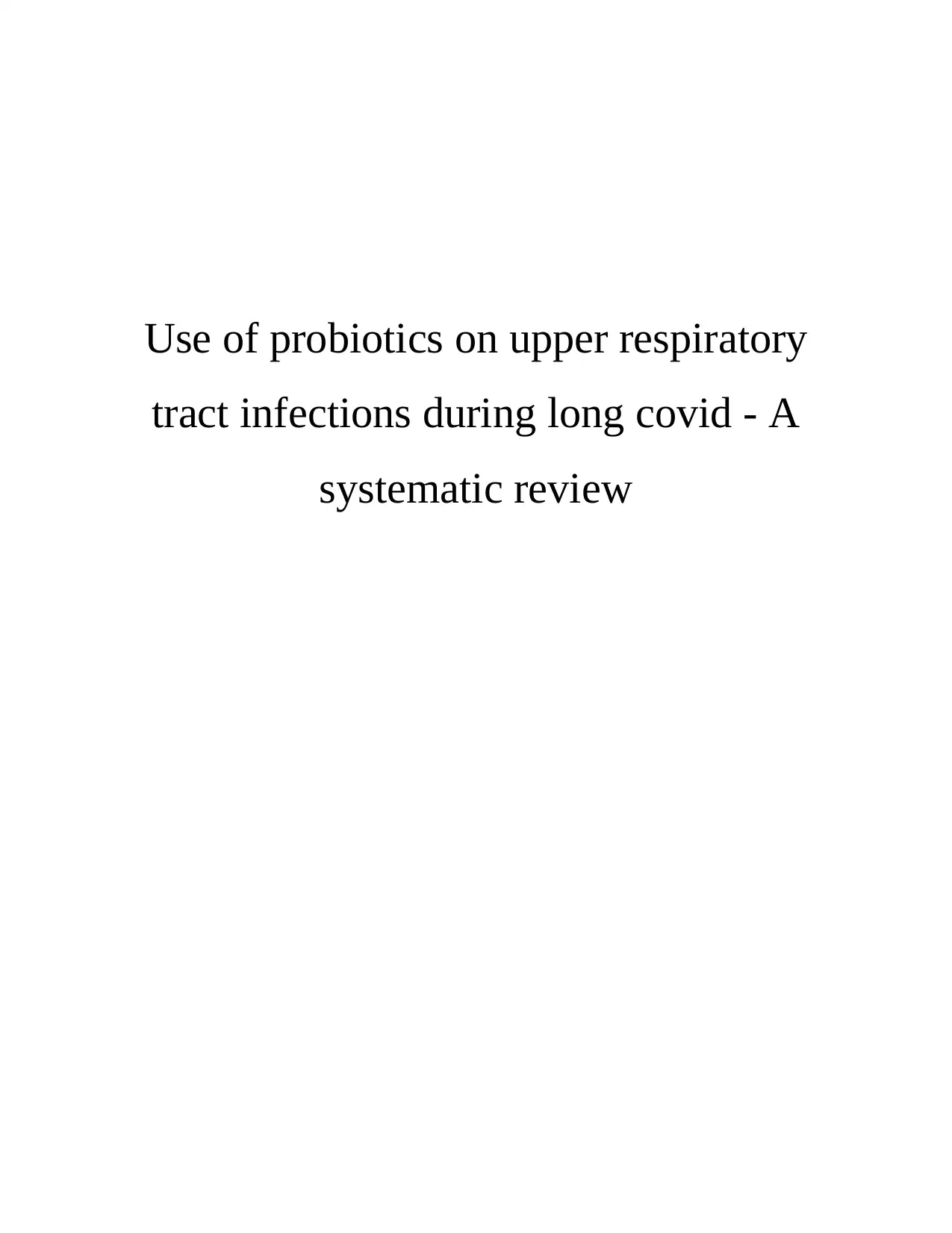
Use of probiotics on upper respiratory
tract infections during long covid - A
systematic review
tract infections during long covid - A
systematic review
Paraphrase This Document
Need a fresh take? Get an instant paraphrase of this document with our AI Paraphraser
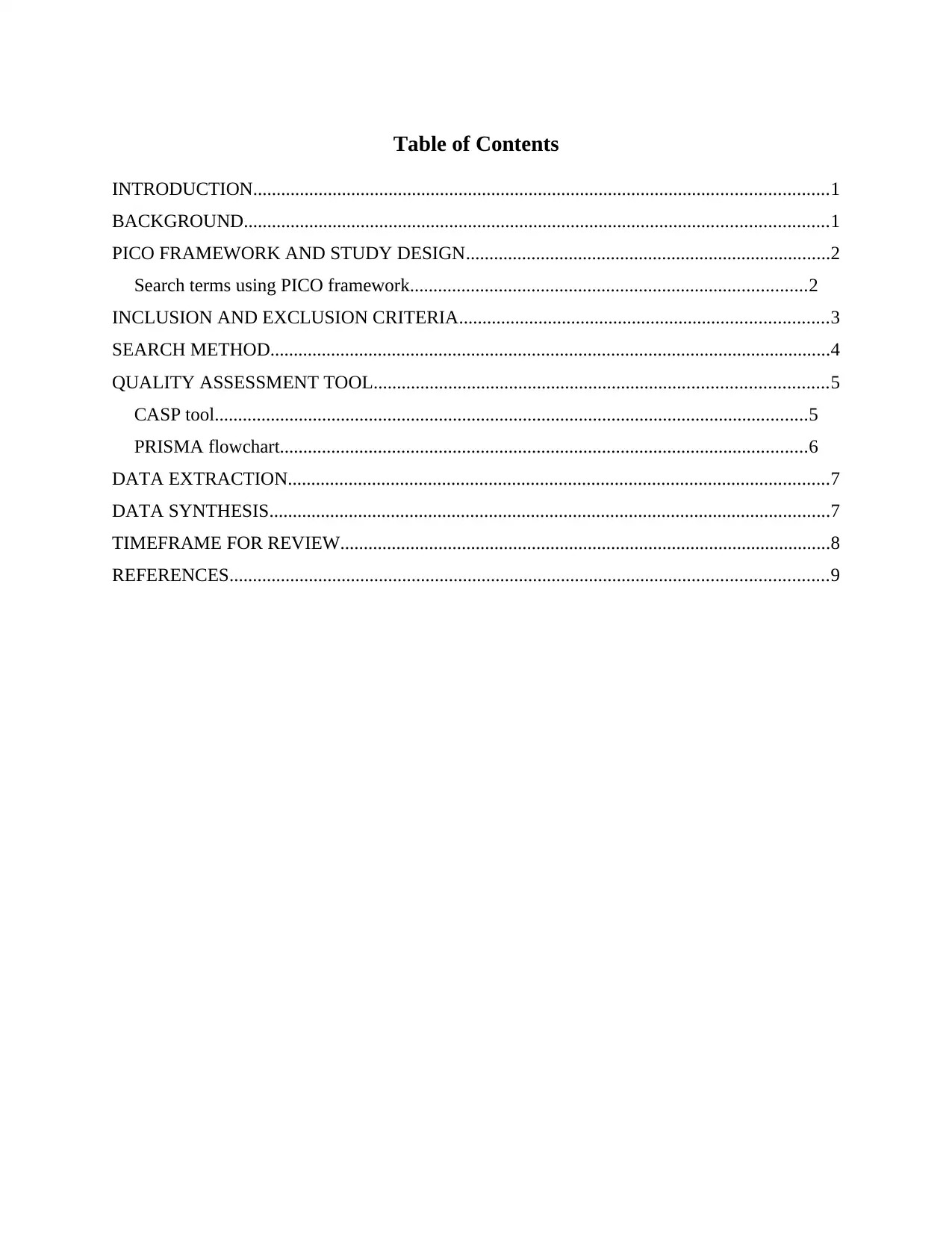
Table of Contents
INTRODUCTION...........................................................................................................................1
BACKGROUND.............................................................................................................................1
PICO FRAMEWORK AND STUDY DESIGN..............................................................................2
Search terms using PICO framework.....................................................................................2
INCLUSION AND EXCLUSION CRITERIA...............................................................................3
SEARCH METHOD........................................................................................................................4
QUALITY ASSESSMENT TOOL.................................................................................................5
CASP tool...............................................................................................................................5
PRISMA flowchart.................................................................................................................6
DATA EXTRACTION....................................................................................................................7
DATA SYNTHESIS........................................................................................................................7
TIMEFRAME FOR REVIEW.........................................................................................................8
REFERENCES................................................................................................................................9
INTRODUCTION...........................................................................................................................1
BACKGROUND.............................................................................................................................1
PICO FRAMEWORK AND STUDY DESIGN..............................................................................2
Search terms using PICO framework.....................................................................................2
INCLUSION AND EXCLUSION CRITERIA...............................................................................3
SEARCH METHOD........................................................................................................................4
QUALITY ASSESSMENT TOOL.................................................................................................5
CASP tool...............................................................................................................................5
PRISMA flowchart.................................................................................................................6
DATA EXTRACTION....................................................................................................................7
DATA SYNTHESIS........................................................................................................................7
TIMEFRAME FOR REVIEW.........................................................................................................8
REFERENCES................................................................................................................................9
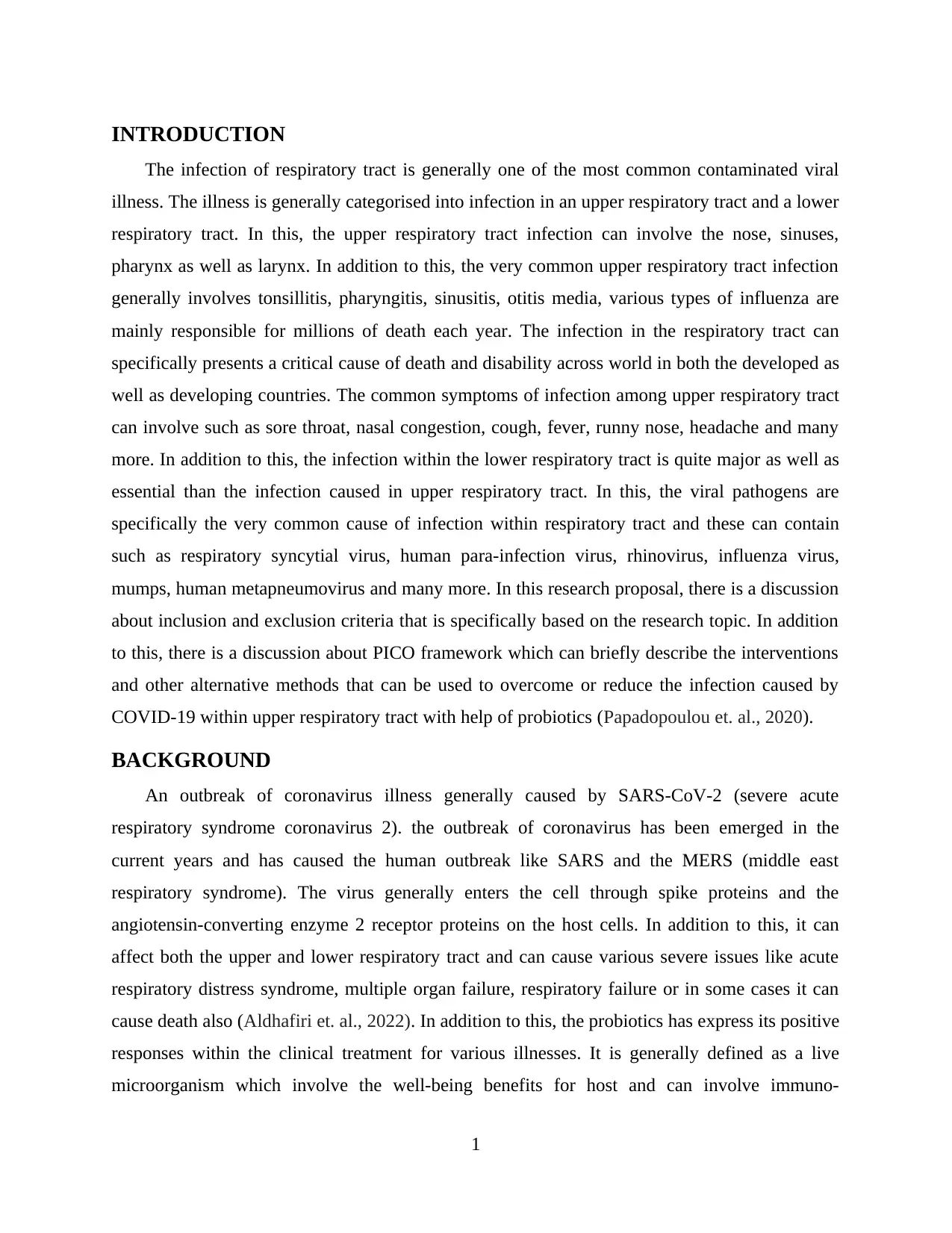
INTRODUCTION
The infection of respiratory tract is generally one of the most common contaminated viral
illness. The illness is generally categorised into infection in an upper respiratory tract and a lower
respiratory tract. In this, the upper respiratory tract infection can involve the nose, sinuses,
pharynx as well as larynx. In addition to this, the very common upper respiratory tract infection
generally involves tonsillitis, pharyngitis, sinusitis, otitis media, various types of influenza are
mainly responsible for millions of death each year. The infection in the respiratory tract can
specifically presents a critical cause of death and disability across world in both the developed as
well as developing countries. The common symptoms of infection among upper respiratory tract
can involve such as sore throat, nasal congestion, cough, fever, runny nose, headache and many
more. In addition to this, the infection within the lower respiratory tract is quite major as well as
essential than the infection caused in upper respiratory tract. In this, the viral pathogens are
specifically the very common cause of infection within respiratory tract and these can contain
such as respiratory syncytial virus, human para-infection virus, rhinovirus, influenza virus,
mumps, human metapneumovirus and many more. In this research proposal, there is a discussion
about inclusion and exclusion criteria that is specifically based on the research topic. In addition
to this, there is a discussion about PICO framework which can briefly describe the interventions
and other alternative methods that can be used to overcome or reduce the infection caused by
COVID-19 within upper respiratory tract with help of probiotics (Papadopoulou et. al., 2020).
BACKGROUND
An outbreak of coronavirus illness generally caused by SARS-CoV-2 (severe acute
respiratory syndrome coronavirus 2). the outbreak of coronavirus has been emerged in the
current years and has caused the human outbreak like SARS and the MERS (middle east
respiratory syndrome). The virus generally enters the cell through spike proteins and the
angiotensin-converting enzyme 2 receptor proteins on the host cells. In addition to this, it can
affect both the upper and lower respiratory tract and can cause various severe issues like acute
respiratory distress syndrome, multiple organ failure, respiratory failure or in some cases it can
cause death also (Aldhafiri et. al., 2022). In addition to this, the probiotics has express its positive
responses within the clinical treatment for various illnesses. It is generally defined as a live
microorganism which involve the well-being benefits for host and can involve immuno-
1
The infection of respiratory tract is generally one of the most common contaminated viral
illness. The illness is generally categorised into infection in an upper respiratory tract and a lower
respiratory tract. In this, the upper respiratory tract infection can involve the nose, sinuses,
pharynx as well as larynx. In addition to this, the very common upper respiratory tract infection
generally involves tonsillitis, pharyngitis, sinusitis, otitis media, various types of influenza are
mainly responsible for millions of death each year. The infection in the respiratory tract can
specifically presents a critical cause of death and disability across world in both the developed as
well as developing countries. The common symptoms of infection among upper respiratory tract
can involve such as sore throat, nasal congestion, cough, fever, runny nose, headache and many
more. In addition to this, the infection within the lower respiratory tract is quite major as well as
essential than the infection caused in upper respiratory tract. In this, the viral pathogens are
specifically the very common cause of infection within respiratory tract and these can contain
such as respiratory syncytial virus, human para-infection virus, rhinovirus, influenza virus,
mumps, human metapneumovirus and many more. In this research proposal, there is a discussion
about inclusion and exclusion criteria that is specifically based on the research topic. In addition
to this, there is a discussion about PICO framework which can briefly describe the interventions
and other alternative methods that can be used to overcome or reduce the infection caused by
COVID-19 within upper respiratory tract with help of probiotics (Papadopoulou et. al., 2020).
BACKGROUND
An outbreak of coronavirus illness generally caused by SARS-CoV-2 (severe acute
respiratory syndrome coronavirus 2). the outbreak of coronavirus has been emerged in the
current years and has caused the human outbreak like SARS and the MERS (middle east
respiratory syndrome). The virus generally enters the cell through spike proteins and the
angiotensin-converting enzyme 2 receptor proteins on the host cells. In addition to this, it can
affect both the upper and lower respiratory tract and can cause various severe issues like acute
respiratory distress syndrome, multiple organ failure, respiratory failure or in some cases it can
cause death also (Aldhafiri et. al., 2022). In addition to this, the probiotics has express its positive
responses within the clinical treatment for various illnesses. It is generally defined as a live
microorganism which involve the well-being benefits for host and can involve immuno-
1
⊘ This is a preview!⊘
Do you want full access?
Subscribe today to unlock all pages.

Trusted by 1+ million students worldwide
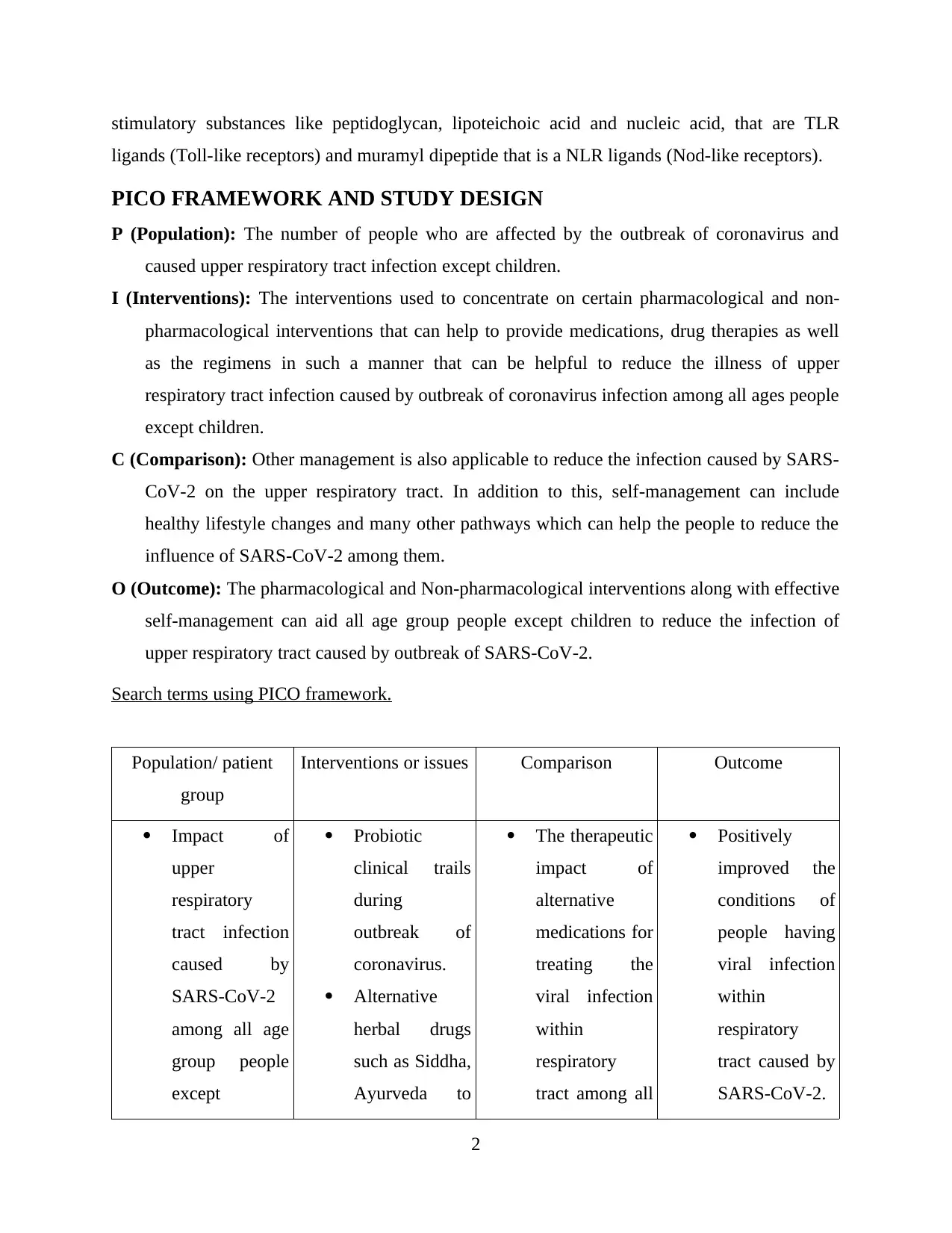
stimulatory substances like peptidoglycan, lipoteichoic acid and nucleic acid, that are TLR
ligands (Toll-like receptors) and muramyl dipeptide that is a NLR ligands (Nod-like receptors).
PICO FRAMEWORK AND STUDY DESIGN
P (Population): The number of people who are affected by the outbreak of coronavirus and
caused upper respiratory tract infection except children.
I (Interventions): The interventions used to concentrate on certain pharmacological and non-
pharmacological interventions that can help to provide medications, drug therapies as well
as the regimens in such a manner that can be helpful to reduce the illness of upper
respiratory tract infection caused by outbreak of coronavirus infection among all ages people
except children.
C (Comparison): Other management is also applicable to reduce the infection caused by SARS-
CoV-2 on the upper respiratory tract. In addition to this, self-management can include
healthy lifestyle changes and many other pathways which can help the people to reduce the
influence of SARS-CoV-2 among them.
O (Outcome): The pharmacological and Non-pharmacological interventions along with effective
self-management can aid all age group people except children to reduce the infection of
upper respiratory tract caused by outbreak of SARS-CoV-2.
Search terms using PICO framework.
Population/ patient
group
Interventions or issues Comparison Outcome
Impact of
upper
respiratory
tract infection
caused by
SARS-CoV-2
among all age
group people
except
Probiotic
clinical trails
during
outbreak of
coronavirus.
Alternative
herbal drugs
such as Siddha,
Ayurveda to
The therapeutic
impact of
alternative
medications for
treating the
viral infection
within
respiratory
tract among all
Positively
improved the
conditions of
people having
viral infection
within
respiratory
tract caused by
SARS-CoV-2.
2
ligands (Toll-like receptors) and muramyl dipeptide that is a NLR ligands (Nod-like receptors).
PICO FRAMEWORK AND STUDY DESIGN
P (Population): The number of people who are affected by the outbreak of coronavirus and
caused upper respiratory tract infection except children.
I (Interventions): The interventions used to concentrate on certain pharmacological and non-
pharmacological interventions that can help to provide medications, drug therapies as well
as the regimens in such a manner that can be helpful to reduce the illness of upper
respiratory tract infection caused by outbreak of coronavirus infection among all ages people
except children.
C (Comparison): Other management is also applicable to reduce the infection caused by SARS-
CoV-2 on the upper respiratory tract. In addition to this, self-management can include
healthy lifestyle changes and many other pathways which can help the people to reduce the
influence of SARS-CoV-2 among them.
O (Outcome): The pharmacological and Non-pharmacological interventions along with effective
self-management can aid all age group people except children to reduce the infection of
upper respiratory tract caused by outbreak of SARS-CoV-2.
Search terms using PICO framework.
Population/ patient
group
Interventions or issues Comparison Outcome
Impact of
upper
respiratory
tract infection
caused by
SARS-CoV-2
among all age
group people
except
Probiotic
clinical trails
during
outbreak of
coronavirus.
Alternative
herbal drugs
such as Siddha,
Ayurveda to
The therapeutic
impact of
alternative
medications for
treating the
viral infection
within
respiratory
tract among all
Positively
improved the
conditions of
people having
viral infection
within
respiratory
tract caused by
SARS-CoV-2.
2
Paraphrase This Document
Need a fresh take? Get an instant paraphrase of this document with our AI Paraphraser
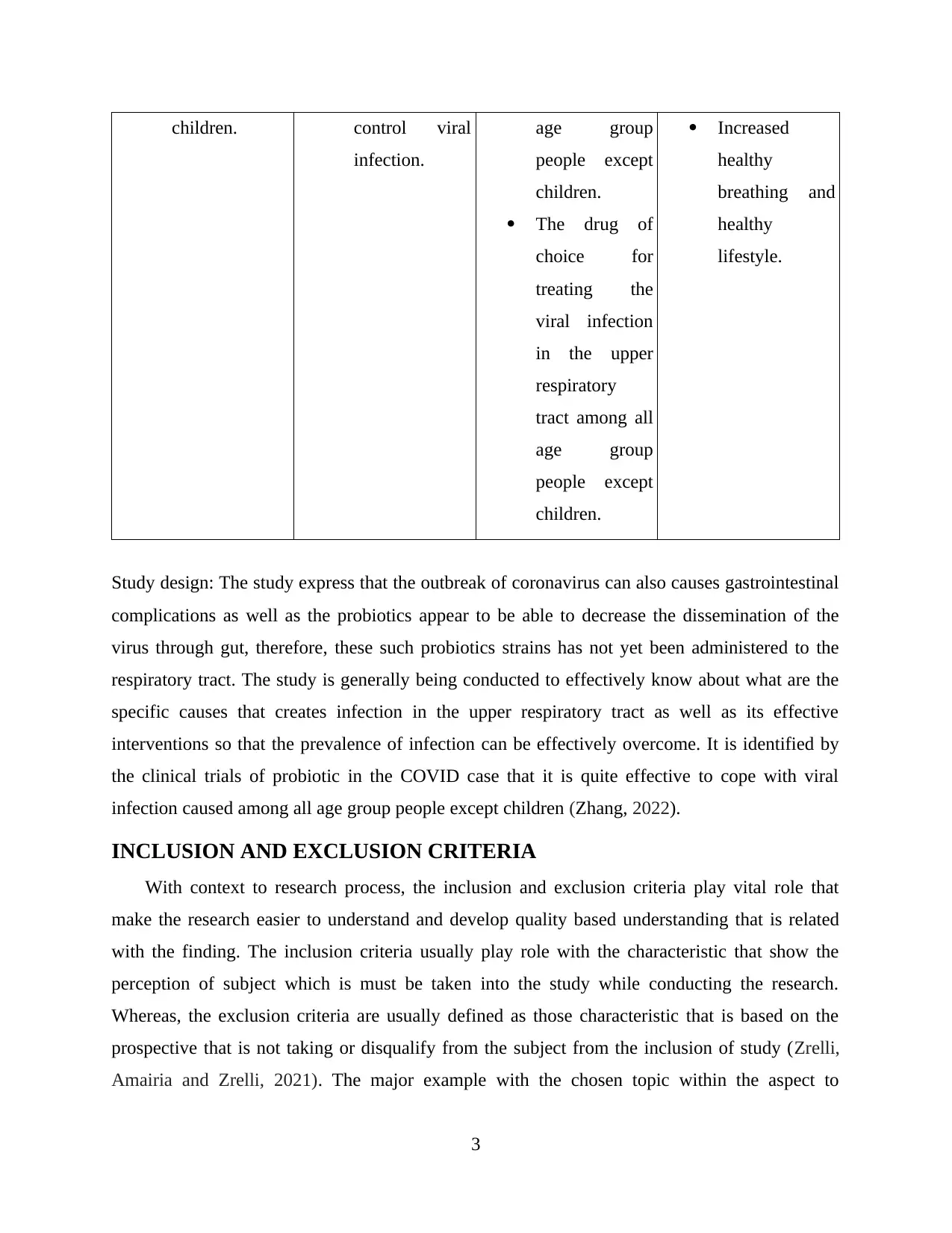
children. control viral
infection.
age group
people except
children.
The drug of
choice for
treating the
viral infection
in the upper
respiratory
tract among all
age group
people except
children.
Increased
healthy
breathing and
healthy
lifestyle.
Study design: The study express that the outbreak of coronavirus can also causes gastrointestinal
complications as well as the probiotics appear to be able to decrease the dissemination of the
virus through gut, therefore, these such probiotics strains has not yet been administered to the
respiratory tract. The study is generally being conducted to effectively know about what are the
specific causes that creates infection in the upper respiratory tract as well as its effective
interventions so that the prevalence of infection can be effectively overcome. It is identified by
the clinical trials of probiotic in the COVID case that it is quite effective to cope with viral
infection caused among all age group people except children (Zhang, 2022).
INCLUSION AND EXCLUSION CRITERIA
With context to research process, the inclusion and exclusion criteria play vital role that
make the research easier to understand and develop quality based understanding that is related
with the finding. The inclusion criteria usually play role with the characteristic that show the
perception of subject which is must be taken into the study while conducting the research.
Whereas, the exclusion criteria are usually defined as those characteristic that is based on the
prospective that is not taking or disqualify from the subject from the inclusion of study (Zrelli,
Amairia and Zrelli, 2021). The major example with the chosen topic within the aspect to
3
infection.
age group
people except
children.
The drug of
choice for
treating the
viral infection
in the upper
respiratory
tract among all
age group
people except
children.
Increased
healthy
breathing and
healthy
lifestyle.
Study design: The study express that the outbreak of coronavirus can also causes gastrointestinal
complications as well as the probiotics appear to be able to decrease the dissemination of the
virus through gut, therefore, these such probiotics strains has not yet been administered to the
respiratory tract. The study is generally being conducted to effectively know about what are the
specific causes that creates infection in the upper respiratory tract as well as its effective
interventions so that the prevalence of infection can be effectively overcome. It is identified by
the clinical trials of probiotic in the COVID case that it is quite effective to cope with viral
infection caused among all age group people except children (Zhang, 2022).
INCLUSION AND EXCLUSION CRITERIA
With context to research process, the inclusion and exclusion criteria play vital role that
make the research easier to understand and develop quality based understanding that is related
with the finding. The inclusion criteria usually play role with the characteristic that show the
perception of subject which is must be taken into the study while conducting the research.
Whereas, the exclusion criteria are usually defined as those characteristic that is based on the
prospective that is not taking or disqualify from the subject from the inclusion of study (Zrelli,
Amairia and Zrelli, 2021). The major example with the chosen topic within the aspect to
3
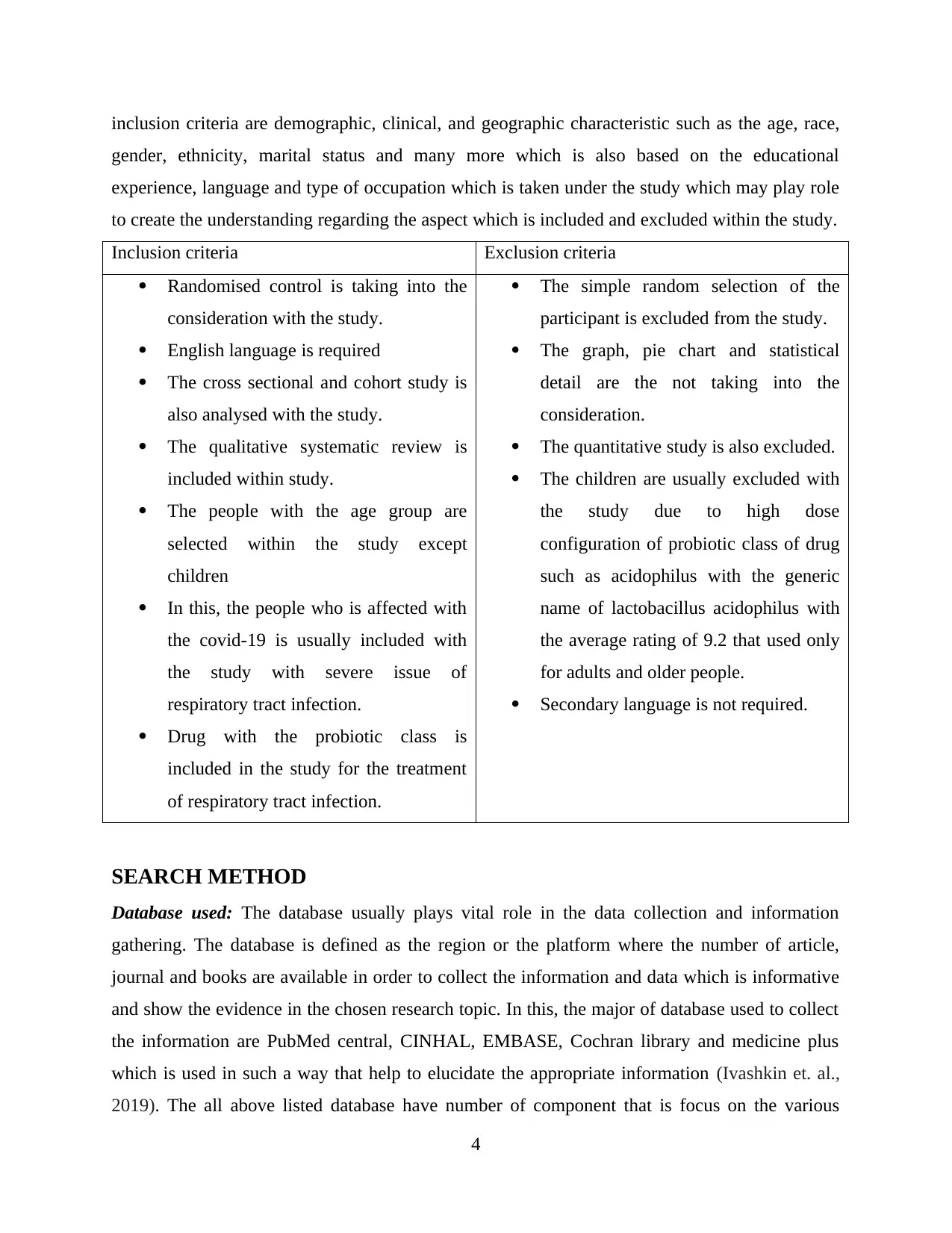
inclusion criteria are demographic, clinical, and geographic characteristic such as the age, race,
gender, ethnicity, marital status and many more which is also based on the educational
experience, language and type of occupation which is taken under the study which may play role
to create the understanding regarding the aspect which is included and excluded within the study.
Inclusion criteria Exclusion criteria
Randomised control is taking into the
consideration with the study.
English language is required
The cross sectional and cohort study is
also analysed with the study.
The qualitative systematic review is
included within study.
The people with the age group are
selected within the study except
children
In this, the people who is affected with
the covid-19 is usually included with
the study with severe issue of
respiratory tract infection.
Drug with the probiotic class is
included in the study for the treatment
of respiratory tract infection.
The simple random selection of the
participant is excluded from the study.
The graph, pie chart and statistical
detail are the not taking into the
consideration.
The quantitative study is also excluded.
The children are usually excluded with
the study due to high dose
configuration of probiotic class of drug
such as acidophilus with the generic
name of lactobacillus acidophilus with
the average rating of 9.2 that used only
for adults and older people.
Secondary language is not required.
SEARCH METHOD
Database used: The database usually plays vital role in the data collection and information
gathering. The database is defined as the region or the platform where the number of article,
journal and books are available in order to collect the information and data which is informative
and show the evidence in the chosen research topic. In this, the major of database used to collect
the information are PubMed central, CINHAL, EMBASE, Cochran library and medicine plus
which is used in such a way that help to elucidate the appropriate information (Ivashkin et. al.,
2019). The all above listed database have number of component that is focus on the various
4
gender, ethnicity, marital status and many more which is also based on the educational
experience, language and type of occupation which is taken under the study which may play role
to create the understanding regarding the aspect which is included and excluded within the study.
Inclusion criteria Exclusion criteria
Randomised control is taking into the
consideration with the study.
English language is required
The cross sectional and cohort study is
also analysed with the study.
The qualitative systematic review is
included within study.
The people with the age group are
selected within the study except
children
In this, the people who is affected with
the covid-19 is usually included with
the study with severe issue of
respiratory tract infection.
Drug with the probiotic class is
included in the study for the treatment
of respiratory tract infection.
The simple random selection of the
participant is excluded from the study.
The graph, pie chart and statistical
detail are the not taking into the
consideration.
The quantitative study is also excluded.
The children are usually excluded with
the study due to high dose
configuration of probiotic class of drug
such as acidophilus with the generic
name of lactobacillus acidophilus with
the average rating of 9.2 that used only
for adults and older people.
Secondary language is not required.
SEARCH METHOD
Database used: The database usually plays vital role in the data collection and information
gathering. The database is defined as the region or the platform where the number of article,
journal and books are available in order to collect the information and data which is informative
and show the evidence in the chosen research topic. In this, the major of database used to collect
the information are PubMed central, CINHAL, EMBASE, Cochran library and medicine plus
which is used in such a way that help to elucidate the appropriate information (Ivashkin et. al.,
2019). The all above listed database have number of component that is focus on the various
4
⊘ This is a preview!⊘
Do you want full access?
Subscribe today to unlock all pages.

Trusted by 1+ million students worldwide
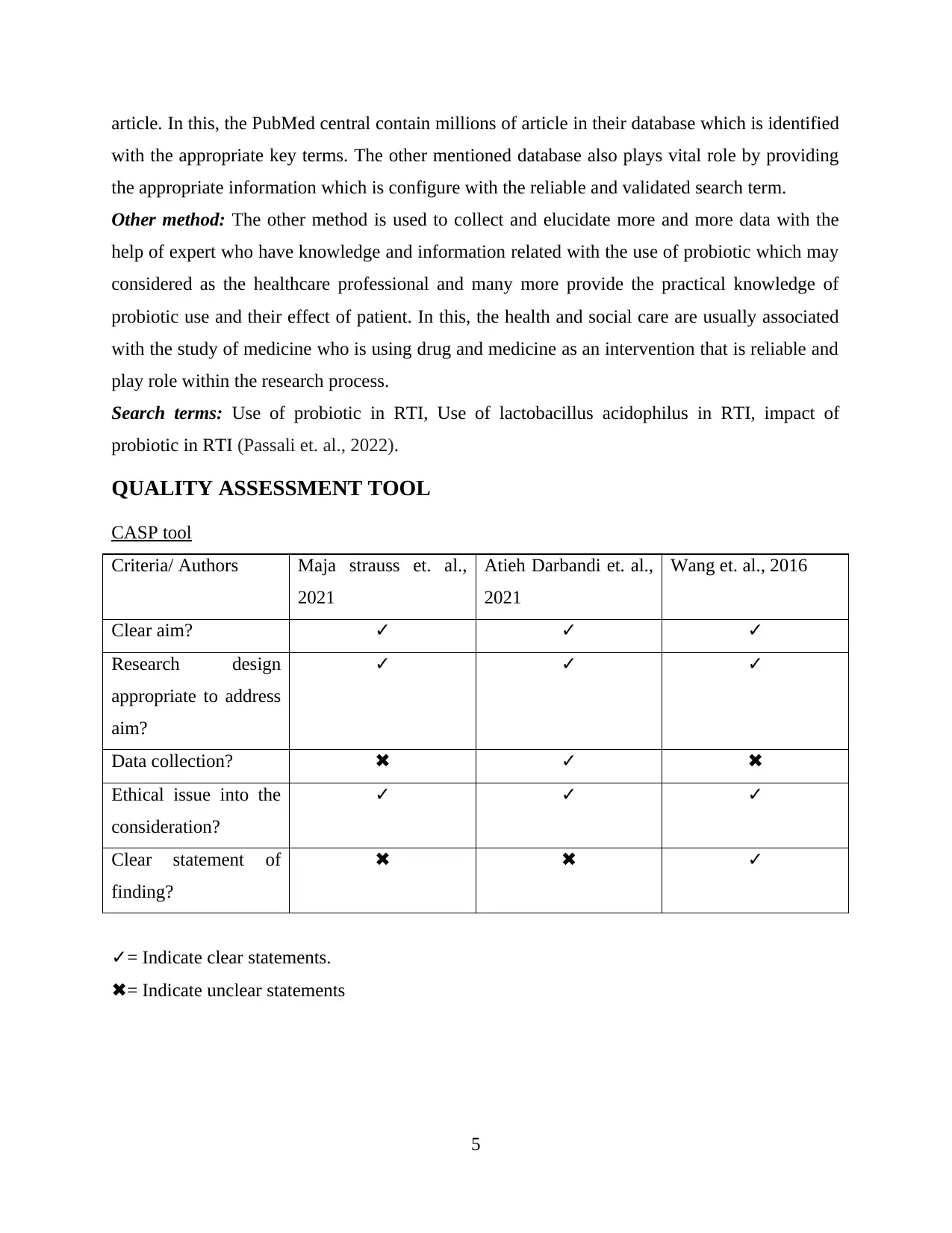
article. In this, the PubMed central contain millions of article in their database which is identified
with the appropriate key terms. The other mentioned database also plays vital role by providing
the appropriate information which is configure with the reliable and validated search term.
Other method: The other method is used to collect and elucidate more and more data with the
help of expert who have knowledge and information related with the use of probiotic which may
considered as the healthcare professional and many more provide the practical knowledge of
probiotic use and their effect of patient. In this, the health and social care are usually associated
with the study of medicine who is using drug and medicine as an intervention that is reliable and
play role within the research process.
Search terms: Use of probiotic in RTI, Use of lactobacillus acidophilus in RTI, impact of
probiotic in RTI (Passali et. al., 2022).
QUALITY ASSESSMENT TOOL
CASP tool
Criteria/ Authors Maja strauss et. al.,
2021
Atieh Darbandi et. al.,
2021
Wang et. al., 2016
Clear aim? ✓ ✓ ✓
Research design
appropriate to address
aim?
✓ ✓ ✓
Data collection? ✖ ✓ ✖
Ethical issue into the
consideration?
✓ ✓ ✓
Clear statement of
finding?
✖ ✖ ✓
✓= Indicate clear statements.
✖= Indicate unclear statements
5
with the appropriate key terms. The other mentioned database also plays vital role by providing
the appropriate information which is configure with the reliable and validated search term.
Other method: The other method is used to collect and elucidate more and more data with the
help of expert who have knowledge and information related with the use of probiotic which may
considered as the healthcare professional and many more provide the practical knowledge of
probiotic use and their effect of patient. In this, the health and social care are usually associated
with the study of medicine who is using drug and medicine as an intervention that is reliable and
play role within the research process.
Search terms: Use of probiotic in RTI, Use of lactobacillus acidophilus in RTI, impact of
probiotic in RTI (Passali et. al., 2022).
QUALITY ASSESSMENT TOOL
CASP tool
Criteria/ Authors Maja strauss et. al.,
2021
Atieh Darbandi et. al.,
2021
Wang et. al., 2016
Clear aim? ✓ ✓ ✓
Research design
appropriate to address
aim?
✓ ✓ ✓
Data collection? ✖ ✓ ✖
Ethical issue into the
consideration?
✓ ✓ ✓
Clear statement of
finding?
✖ ✖ ✓
✓= Indicate clear statements.
✖= Indicate unclear statements
5
Paraphrase This Document
Need a fresh take? Get an instant paraphrase of this document with our AI Paraphraser

PRISMA flowchart
6
Records identified from*:
Databases (n = 220)
Registers (n =120)
Records removed before
screening:
Duplicate records removed (n
=45)
Records marked as ineligible
by automation tools (n =30)
Records removed for other
reasons (n = 25)
Records screened
(n = 180)
Records excluded**
(n = 50)
Reports sought for retrieval
(n = 110) Reports not retrieved
(n = 50)
Reports assessed for eligibility
(n = 130)
Reports excluded:
Reason 1 (n = 10)
Reason 2 (n = 30)
Reason 3 (n = 60)
etc.
Studies included in review
(n = 80)
Reports of included studies
(n = 30)
Identification of studies via databases and registers
Identification
Screening
Included
6
Records identified from*:
Databases (n = 220)
Registers (n =120)
Records removed before
screening:
Duplicate records removed (n
=45)
Records marked as ineligible
by automation tools (n =30)
Records removed for other
reasons (n = 25)
Records screened
(n = 180)
Records excluded**
(n = 50)
Reports sought for retrieval
(n = 110) Reports not retrieved
(n = 50)
Reports assessed for eligibility
(n = 130)
Reports excluded:
Reason 1 (n = 10)
Reason 2 (n = 30)
Reason 3 (n = 60)
etc.
Studies included in review
(n = 80)
Reports of included studies
(n = 30)
Identification of studies via databases and registers
Identification
Screening
Included

DATA EXTRACTION
With context to research process, the data extraction is defined as the process of procuring
the data which is from the given and analysed source of moving into the new context with the
either on-site or the term of hybrid. In this, there are various of intervention are usually taken
which is may be complex and often performed manually. The finding of data extraction is help to
provide the information and knowledge with respiratory tract infection due to COVID-19 is the
major problem and with this context the probiotic are used in defined which show their relevance
in disease (Winkle, 2020). In addition, the probiotic is defined as the viable bacteria that usually
colonize the intestine and affect the human body intestinal microbial balance. Moreover, the
accumulation of the suggested probiotic consumption may reduce the influence of modify
respiratory tract infection. In this, the systematic review within the research process are usually
carry the aspect of the randomised control trail which is help to analyse the effect of probiotic
consumption in the upper respiratory tract that affected due to the COVID-19. The accountability
of the respiratory disease is usually providing the factor which is most common cause that
include rhinovirus, respiratory syncytial virus, human parainfluenza virus, human
metapenumovirus, mumps and many more bacterial pathogens which is responsible to cause the
issue of respiratory tract infection. The SARS-co-vin is also a major aspect which is virus and
cause the issue of respiratory failure which affect the alveoli that create shortness of breath
(Zhang et. al., 2022).
DATA SYNTHESIS
Data synthesis is defined as the method and recommendation in order to process the
synthesis of data that bringing together data from the set of inclusion which is included within
the study with the main aim of drawing that based on the aspect of conclusion about the form of
body which is based on evidence. Within the context with the systematic review, the qualitative
method is usually taking into the consideration which help to show the concept, model and
theory which create the knowledge and information that is related with the use of probiotic in the
upper respiratory tract (The effect of probiotics on respiratory tract infection with special
emphasis on COVID-19: Systemic review 2010–20, 2021). The method that uses statistical
technique in order to combine the statistical technique which is show the outcome of various
studies that used to obtain the estimation of the overall effect of the intervention or variable on
7
With context to research process, the data extraction is defined as the process of procuring
the data which is from the given and analysed source of moving into the new context with the
either on-site or the term of hybrid. In this, there are various of intervention are usually taken
which is may be complex and often performed manually. The finding of data extraction is help to
provide the information and knowledge with respiratory tract infection due to COVID-19 is the
major problem and with this context the probiotic are used in defined which show their relevance
in disease (Winkle, 2020). In addition, the probiotic is defined as the viable bacteria that usually
colonize the intestine and affect the human body intestinal microbial balance. Moreover, the
accumulation of the suggested probiotic consumption may reduce the influence of modify
respiratory tract infection. In this, the systematic review within the research process are usually
carry the aspect of the randomised control trail which is help to analyse the effect of probiotic
consumption in the upper respiratory tract that affected due to the COVID-19. The accountability
of the respiratory disease is usually providing the factor which is most common cause that
include rhinovirus, respiratory syncytial virus, human parainfluenza virus, human
metapenumovirus, mumps and many more bacterial pathogens which is responsible to cause the
issue of respiratory tract infection. The SARS-co-vin is also a major aspect which is virus and
cause the issue of respiratory failure which affect the alveoli that create shortness of breath
(Zhang et. al., 2022).
DATA SYNTHESIS
Data synthesis is defined as the method and recommendation in order to process the
synthesis of data that bringing together data from the set of inclusion which is included within
the study with the main aim of drawing that based on the aspect of conclusion about the form of
body which is based on evidence. Within the context with the systematic review, the qualitative
method is usually taking into the consideration which help to show the concept, model and
theory which create the knowledge and information that is related with the use of probiotic in the
upper respiratory tract (The effect of probiotics on respiratory tract infection with special
emphasis on COVID-19: Systemic review 2010–20, 2021). The method that uses statistical
technique in order to combine the statistical technique which is show the outcome of various
studies that used to obtain the estimation of the overall effect of the intervention or variable on
7
⊘ This is a preview!⊘
Do you want full access?
Subscribe today to unlock all pages.

Trusted by 1+ million students worldwide

the defined outcome. Moreover, the use of probiotics is defined as the aspect which is used
within the Covid-19 as an intervention. The qualitative method of systematic review is used
which is based on the identification that is place for the reliable and validated information with
the proper open ended question and use of concept.
Qualitative method in systematic review: In this, the systematic review is usually based on
the quantitative and qualitative. The research usually covers the aspect of qualitative systematic
review which is derive from the data from the observation which is reliable and validated with
the topic of use of probiotic within the COVID-19. In addition, for the systematic review the
major of data is collected from the interview or the verbal interaction and concentrate on the
meaning and words. In this, due the qualitative systematic review the appropriate and functional
aspect are used to follow in order to collect and synthesize proper data selection and collection.
In the above section some of the method which is generally used for systematic review are
formulation of clinical question that is PICO which is already developed, the development of
protocol that is based on the inclusion and exclusion criteria. In addition, they used to perform
the detail and broad literature search with the screening of abstract of the studies which is
identified and due to this the potential risk of biasness is reduced (Probiotics for prevention and
treatment of respiratory tract infections in children, 2016).
TIMEFRAME FOR REVIEW
Activities/Months April May June July August September October
Introduction
Literature review
Quality appraisal
Data extraction
Study design
Finding
8
within the Covid-19 as an intervention. The qualitative method of systematic review is used
which is based on the identification that is place for the reliable and validated information with
the proper open ended question and use of concept.
Qualitative method in systematic review: In this, the systematic review is usually based on
the quantitative and qualitative. The research usually covers the aspect of qualitative systematic
review which is derive from the data from the observation which is reliable and validated with
the topic of use of probiotic within the COVID-19. In addition, for the systematic review the
major of data is collected from the interview or the verbal interaction and concentrate on the
meaning and words. In this, due the qualitative systematic review the appropriate and functional
aspect are used to follow in order to collect and synthesize proper data selection and collection.
In the above section some of the method which is generally used for systematic review are
formulation of clinical question that is PICO which is already developed, the development of
protocol that is based on the inclusion and exclusion criteria. In addition, they used to perform
the detail and broad literature search with the screening of abstract of the studies which is
identified and due to this the potential risk of biasness is reduced (Probiotics for prevention and
treatment of respiratory tract infections in children, 2016).
TIMEFRAME FOR REVIEW
Activities/Months April May June July August September October
Introduction
Literature review
Quality appraisal
Data extraction
Study design
Finding
8
Paraphrase This Document
Need a fresh take? Get an instant paraphrase of this document with our AI Paraphraser

REFERENCES
Books and Journals
Papadopoulou, S.K., Mantzorou, M., Koutridou, D., Tassoulas, E., Sakellaropoulou, S.,
Biskanaki, F., Xatziapostolou, E. and Papandreou, D., 2020. COVID-19 disease, obesity
and micronutrients: an updated narrative review of the literature. Nutrition & Food
Science.
Aldhafiri, F.K., 2022. COVID-19 and gut dysbiosis, understanding the role of probiotic
supplements in reversing gut dysbiosis and immunity. Nutrition Clinique et
Métabolisme.
Zhang, L., Xu, Z., Mak, J.W., Chow, K.M., Lui, G., Li, T.C., Wong, C.K., Chan, P.K., Ching,
J.Y., Fujiwara, Y. and Chan, F.K., 2022. A novel gut microbiota‐derived synbiotic
formula (SIM01) as an adjuvant therapy for COVID‐19: An open‐label pilot
study. Journal of Gastroenterology and Hepatology.
Zrelli, S., Amairia, S. and Zrelli, M., 2021. Respiratory syndrome coronavirus‐2 response:
Microbiota as lactobacilli could make the difference. Journal of Medical
Virology, 93(6), pp.3288-3293.
Ivashkin, V.T., Zol’nikova, O.Y., Potskhverashvili, N.D., Kokina, N.I., Buyeverova, E.L.,
Sedova, A.V. and Trukhmanov, A.S., 2019. Perspectives of treatment with probiotics in
acute respiratory infections. PULMONOLOGIYA, 29(5), pp.612-619.
Passali, D., Passali, F.M. and Damiani, V., 2022. Recurrent Respiratory Infections in Childhood:
The Importance of Local Microbiota Modulation. In Pediatric ENT Infections (pp. 55-
62). Springer, Cham.
Abdel-Bakky, M.S. and Mohamed, A.A., Human Microbiome and COVID-19: a Possible
Interplay on Angiotensin Converting Enzyme-2 Ahmed A. Tammam1, 2, Osama A.
Faried3, Eman H. Nadwa4, 5. tuberculosis, 3, p.5.
Winkle, A., 2020. Children's respiratory tract infections: Antibiotic use for children's respiratory
tract infections. AJP: The Australian Journal of Pharmacy, 101(1197), pp.50-55.
Zhang, W., Huang, J., Liu, H., Wen, X., Zheng, Q. and Li, L., 2022. Whether immunostimulants
are effective in susceptible children suffering from recurrent respiratory tract infections:
a modeling analysis based on literature aggregate data. The Journal of Clinical
Pharmacology, 62(2), pp.245-253.
Online
Beneficial effects of probiotics in upper respiratory tract infections and their mechanical actions
to antagonize pathogens, 2012 [Online] Available
through:<https://sfamjournals.onlinelibrary.wiley.com/doi/full/10.1111/j.1365-
2672.2012.05394.x>
Probiotics in Preventing Acute Upper Respiratory Tract Infections, 2017 [Online] Available
through:<https://journals.lww.com/ajnonline/Fulltext/2017/12000/Probiotics_in_Preventing_Acu
te_Upper_Respiratory.37.aspx>
9
Books and Journals
Papadopoulou, S.K., Mantzorou, M., Koutridou, D., Tassoulas, E., Sakellaropoulou, S.,
Biskanaki, F., Xatziapostolou, E. and Papandreou, D., 2020. COVID-19 disease, obesity
and micronutrients: an updated narrative review of the literature. Nutrition & Food
Science.
Aldhafiri, F.K., 2022. COVID-19 and gut dysbiosis, understanding the role of probiotic
supplements in reversing gut dysbiosis and immunity. Nutrition Clinique et
Métabolisme.
Zhang, L., Xu, Z., Mak, J.W., Chow, K.M., Lui, G., Li, T.C., Wong, C.K., Chan, P.K., Ching,
J.Y., Fujiwara, Y. and Chan, F.K., 2022. A novel gut microbiota‐derived synbiotic
formula (SIM01) as an adjuvant therapy for COVID‐19: An open‐label pilot
study. Journal of Gastroenterology and Hepatology.
Zrelli, S., Amairia, S. and Zrelli, M., 2021. Respiratory syndrome coronavirus‐2 response:
Microbiota as lactobacilli could make the difference. Journal of Medical
Virology, 93(6), pp.3288-3293.
Ivashkin, V.T., Zol’nikova, O.Y., Potskhverashvili, N.D., Kokina, N.I., Buyeverova, E.L.,
Sedova, A.V. and Trukhmanov, A.S., 2019. Perspectives of treatment with probiotics in
acute respiratory infections. PULMONOLOGIYA, 29(5), pp.612-619.
Passali, D., Passali, F.M. and Damiani, V., 2022. Recurrent Respiratory Infections in Childhood:
The Importance of Local Microbiota Modulation. In Pediatric ENT Infections (pp. 55-
62). Springer, Cham.
Abdel-Bakky, M.S. and Mohamed, A.A., Human Microbiome and COVID-19: a Possible
Interplay on Angiotensin Converting Enzyme-2 Ahmed A. Tammam1, 2, Osama A.
Faried3, Eman H. Nadwa4, 5. tuberculosis, 3, p.5.
Winkle, A., 2020. Children's respiratory tract infections: Antibiotic use for children's respiratory
tract infections. AJP: The Australian Journal of Pharmacy, 101(1197), pp.50-55.
Zhang, W., Huang, J., Liu, H., Wen, X., Zheng, Q. and Li, L., 2022. Whether immunostimulants
are effective in susceptible children suffering from recurrent respiratory tract infections:
a modeling analysis based on literature aggregate data. The Journal of Clinical
Pharmacology, 62(2), pp.245-253.
Online
Beneficial effects of probiotics in upper respiratory tract infections and their mechanical actions
to antagonize pathogens, 2012 [Online] Available
through:<https://sfamjournals.onlinelibrary.wiley.com/doi/full/10.1111/j.1365-
2672.2012.05394.x>
Probiotics in Preventing Acute Upper Respiratory Tract Infections, 2017 [Online] Available
through:<https://journals.lww.com/ajnonline/Fulltext/2017/12000/Probiotics_in_Preventing_Acu
te_Upper_Respiratory.37.aspx>
9
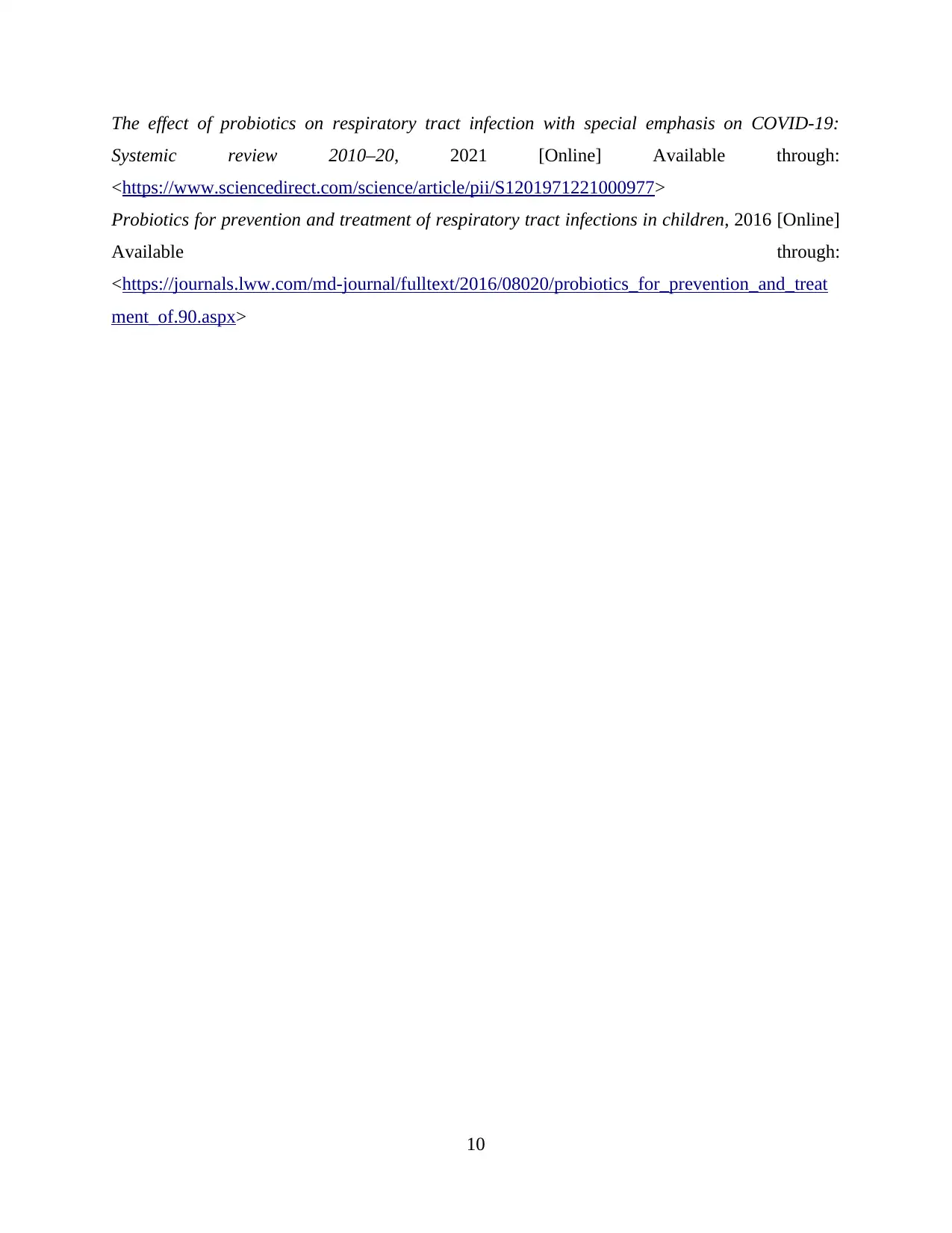
The effect of probiotics on respiratory tract infection with special emphasis on COVID-19:
Systemic review 2010–20, 2021 [Online] Available through:
<https://www.sciencedirect.com/science/article/pii/S1201971221000977>
Probiotics for prevention and treatment of respiratory tract infections in children, 2016 [Online]
Available through:
<https://journals.lww.com/md-journal/fulltext/2016/08020/probiotics_for_prevention_and_treat
ment_of.90.aspx>
10
Systemic review 2010–20, 2021 [Online] Available through:
<https://www.sciencedirect.com/science/article/pii/S1201971221000977>
Probiotics for prevention and treatment of respiratory tract infections in children, 2016 [Online]
Available through:
<https://journals.lww.com/md-journal/fulltext/2016/08020/probiotics_for_prevention_and_treat
ment_of.90.aspx>
10
⊘ This is a preview!⊘
Do you want full access?
Subscribe today to unlock all pages.

Trusted by 1+ million students worldwide
1 out of 12
Related Documents
Your All-in-One AI-Powered Toolkit for Academic Success.
+13062052269
info@desklib.com
Available 24*7 on WhatsApp / Email
![[object Object]](/_next/static/media/star-bottom.7253800d.svg)
Unlock your academic potential
Copyright © 2020–2026 A2Z Services. All Rights Reserved. Developed and managed by ZUCOL.





